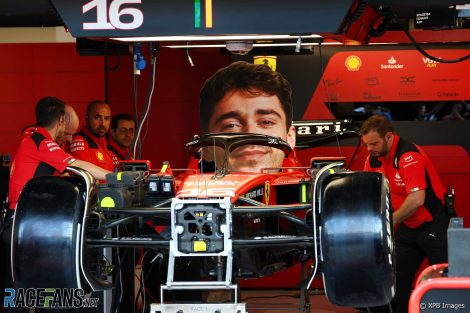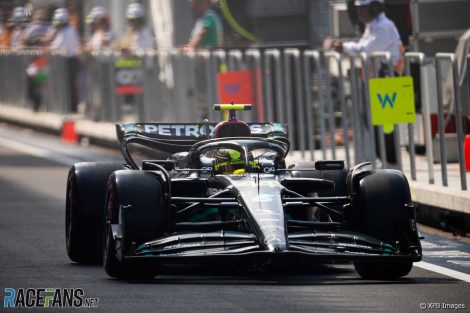The 2023 Formula 1 season was supposed to be the longest in history with a whopping 24 grands prix crammed into the span of 268 days.
Then, with the cancellation of the Chinese Grand Prix in April, the calendar fell to 23 rounds – still enough for the longest ever season.
Now, this weekend’s Emilia-Romagna Grand Prix is not taking place as a result of appalling flooding that has led to major damage and disruption in the region. With little prospect of the race being rescheduled until later in the season, it looks like this year’s world championship will once again be contested over 22 rounds.
But with another race off the schedule, what does that mean for teams and drivers when it comes to this year’s championship?
Components don’t have to last as long
The reduction in the number of races does not have any impact on power unit component allocations. As a result, the teams and drivers know their hardware has to complete one fewer race, which could prove the difference between taking and avoiding a penalty at the end of the year.

They had already been given a helping hand through a rules change last month. F1, teams and the FIA agreed to increase the allocations of internal combustion engines, MGU-H, MGU-K and turbochargers each by one for the remainder of the season.
Drivers are still limited to the two energy stores and control electronics that they started the 2023 season with. There is no provision in the sporting regulations to reduce the maximum component allowance if races are cancelled while the season is in progress.
However, there is a mechanism for the number of so-called ‘restricted-number components (RNC)’ – such as gearboxes and gearbox casings – to be reduced if the number of races also falls. But this will not affect the 2023 season as things stand, as both gearbox cases and gearbox casings are limited to four each whether the number of races are 23, 22 or even 20 or fewer. Each driver would have been allocated five of each had the original 24-round calendar been achieved, however the allocation was reduced to four with the cancellation of the Chinese Grand Prix, meaning the loss of Imola has no additional effect.
Less pressure on budgets
One of the first questions that comes to mind in the aftermath of another race being cancelled so early in the season is what impact will the loss of Imola have on teams’ budget caps for the 2023 season. particularly as the base budget cap limit is now at its lowest level, just $135 million (£108.8m), before adjustments.

The late cancellation of the race means the spending limit won’t be adjusted. Under the current F1 financial regulations, article 2.3 outlines that any grand prix cancelled less than three months before it was set to take place will be deemed to have taken place under the budget cap. The cap will only be reduced if fewer than 21 grands prix take place in a season, and with Imola technically still counting under the financial regulations, the budget cap remains unchanged from how it would have been if both rounds had taken place.
But the cancellation of the second race of the season will not be without consequences for teams. As they will not be running their cars this weekend, they will naturally save on the costs of running and maintaining their cars. Teams will also escape damage costs from any potential accidents, crashes or technical failures that could have happened over the weekend and could earn back hospitality costs from refunds on hotels they will not be staying in, depending on arrangements.
The funds saved from this weekend will not simply sit in team’s accounts and allow them a buffer on the cap, however. They will likely invest that money into other areas – such as car development or in facilities – in order to maximise their competitive advantage.
Advert | Become a RaceFans supporter and
Upgrades delayed
One important impact of this weekend’s racing being called off is that many of the teams will have to wait at least one extra week to collect any data from their upgrades packages they would have brought to the Imola circuit. Following three weeks off from racing in April with the cancellation of China, many teams brought upgrades to Baku for the Azerbaijan Grand Prix, but Imola was marked on many teams’ calendars as when they would likely introduce their biggest upgrades of the season to date.

With no race, there will be no opportunity for teams to gather data on their new parts around a conventional, permanent race track like Imola. Instead, teams now have to wait an extra week until Monaco – potentially the worst possible venue to introduce updates due it being another street circuit with by far the slowest lap speed on the calendar.
However, Mercedes say they will continue to bring their planned Imola upgrades to next weekend in Monte Carlo. Ferrari, it appears, will delay introducing their revised suspension until the following round at Barcelona, the next permanent circuit on the schedule.
The impact of the cancellation of Imola on team performance and the pecking order will be hard to quantify, but it will inevitably have some influence over how confident teams are in their cars by the time they arrive in Spain in just under two weeks’ time.
Advert | Become a RaceFans supporter and
Tyre test shelved
This weekend was supposed to see Formula 1 experiment with a brand new tyre allocation format at Imola. The ‘alternative tyre allocation’ was supposed to reduce the total number of compounds each driver could use through the weekend from 13 sets down to 11. It would also have compelled all drivers to run hard compound tyres in Q1, mediums in Q2 and softs only in Q3.

The format change was supposed to help tyre suppliers Pirelli explore whether they could reduce the quantity of tyres they need to bring to each race weekend to decrease the environmental impact of transporting those 160 additional dry tyres to each circuit without having a major effect on the on-track competition. However, that test can no longer be carried out.
There is one other test of the alternative tyre allocation planned for later this year, however the track which will be used has not been determined. Due to the lead times involved in manufacturing and transporting tyres, it is unlikely to take place at any of the immediately following races.
Sprint events such as the Austrian Grand Prix are not an option either, and Pirelli plans to introduce a new specification of dry tyres from the British Grand Prix at Silverstone, which may rule that event out. It may not be until the Hungarian Grand Prix, just before the summer break, that the format can finally be tested.
Advert | Become a RaceFans supporter and
Street race streak
With Imola’s race not taking place, teams and drivers will now face their fifth street circuit in succession when they arrive in Monaco next weekend. Following the opening round of the season in Bahrain, drivers have now had to contend with Jeddah, Albert Park, Baku, Miami and now Monaco.
While all of those circuits have their own characteristics and vary in many ways from each other, it’s the first time that Formula 1 has ever had five consecutive grands prix all taking place around temporary street circuits, rather than a conventional road course.
Gasly gets a reprieve
While no one in Formula 1 will be happy with the tragic reason for Imola’s cancellation, the lack of racing this weekend works in Pierre Gasly’s favour.
Having been just two penalty points away from a potential race ban after accruing ten over the bulk of last season through a series of incidents, Gasly has managed to avoid picking up any more up to this stage in the early part of the 2023 season. He’s had a few near-misses during this time, notably in Australia, where he was lucky to avoid a sanction after taking out his team mate at the restart.
Imola was set to be the last weekend at which Gasly would race with the cloud of a ban hanging over him, with two points set to be wiped from his record on Monday. Now it’s been called off Gasly will be down to eight penalty points at Monaco next weekend.
While still under risk of a ban if he collects more points over the year – and still more than any other driver – it will allow him some breathing space. Gasly will next lose a point following the British Grand Prix weekend in early July.
Advert | Become a RaceFans supporter and
















